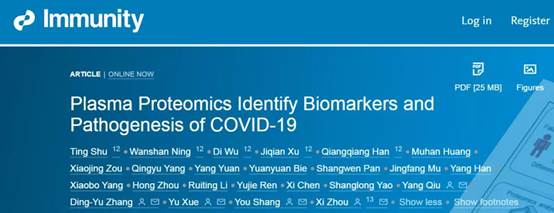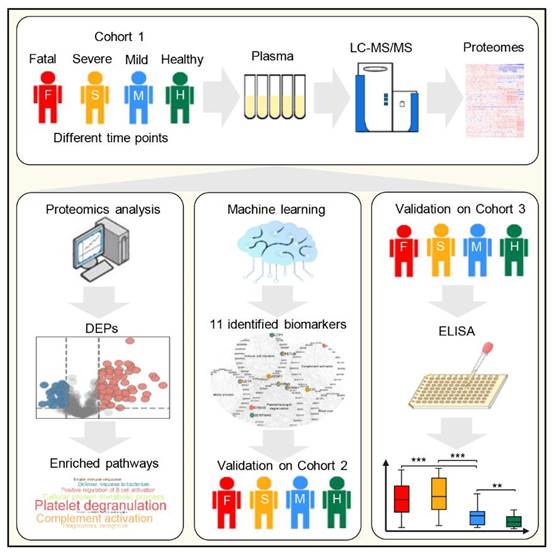October 20th, the internationally renowned journal Immunity published online Plasma Proteomics the Identify Biomarkers and Pathogenesis of COVID-19, which is the result of multi-team cooperation in HUST. The result reveals the pathogenesis and potential therapeutic targets of COVID-19.

It has been reported that more than 19% of COVID-19 patients develop severe disease with a mortality rate of more than 60%. Symptoms such as fever, pneumonia, sepsis, respiratory failure, acute respiratory distress, and multi-organ injury in severe patients are usually associated with pathophysiological changes such as alveolar macrophage activation, lymphocytosis, cytokine release syndrome, microthrombus formation, and intravascular coagulation. However, little is known about the biomarkers and pathogenesis of COVID-19.

The study identified a large number of molecular changes in plasma proteins associated with COVID-19 by quantitative proteomic analysis of plasma samples from a group of COVID-19 patients, including non-survivors and survivors who had recovered from mild or severe illness. In addition, based on machine learning algorithm, an optimal combination selection algorithm called POC-19 (Prioritization of Optimal biomarker Combinations for COVID–19) was developed. Eleven biomarkers were identified that accurately predicted the severity of disease in COVID-19 patients. One set of biomarkers was validated by an independent plasma proteome cohort and further validated by ELISA on a larger cohort. These biomarkers include host proteins that play a key role in major pathophysiological pathways. These findings reveal the pathogenesis of COVID-19 and potential therapeutic targets.
The corresponding authors of this paper are Xi Zhou, a researcher of Wuhan Institute of Viruses, Chinese Academy of Sciences, Yang Qiu, a young researcher of Wuhan Institute of Viruses, Chinese Academy of Sciences, Dingyu Zhang, the president of Wuhan Jinyitan Hospital; You Shang, a professor of Wuhan Union Hospital and Yu Xue, a professor of School of Life Science & Technology. The co-first authors are Dr. Ting Shu and Dr. Di Wu of the Joint Laboratory of Infectious Diseases and Health of Wuhan Jinyintan Hospital and Wuhan Institute of Virology, Chinese Academy of Sciences, Dr. Jiqian Xu and Doctoral Student Wanshan Ning of our university and Dr. Qiangqiang Han of Wuhan SpecAlly . This research is supported by the National Natural Science Foundation of China, the Strategic Key Research Program of the Chinese Academy of Sciences, the National Science and Technology Major Projects and other projects.
Source: School of Life Science & Technology
Written by: Aoyi Zhang
Edited by: Scott, Yumeng Peng
